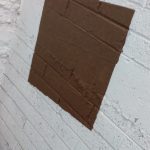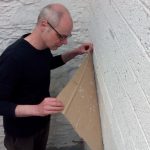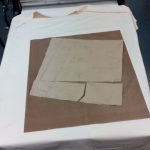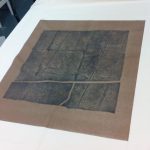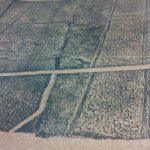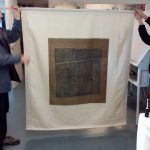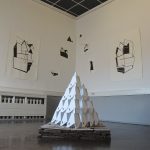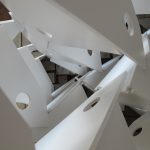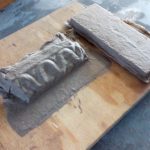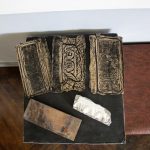Taking place in 2015 in the Vitebsk Centre for Contemporary Art and 5A Pravdy St. Vitebsk, Belarus, Over the Sun was a three person exhibition featuring myself, Sean Hanrahan and Josh Dannin.
Organised and selected by Sean, the exhibition is our tribute to the enduring legacy of the work of Russian artist Kazimir Malevich. No. 5A, Pravdy St. Vitebsk is where Kazimir Malevich worked, taught and lived in the famous UNOVIS school from 1919 to 1923. While there he continued to develop and teach his Suprematist style of painting, which has been extremely influential in the subsequent development of geometric abstraction, particularly in the West. My practice has long been influenced by Malevich’s legacy, having completed my degree dissertation on his work.
Currently undergoing extensive renovation, 5A was the location of one of a series of temporary interventions of canvas banners made by the three artists. This aspect of the show was inspired by the UNOVIS group’s political activities in the city in the early 1920s. As widespread poverty denied them the funds to produce new architecture, they augmented the existing environment in the form of signboards and banners hung on buildings and shops, and propaganda panels that decorated the sides of streetcars.
For my banner I decided to pay homage to Malevich’s famous Black Square painting, and make an histotical, architectural reference to the original UNOVIS building. I produced a relief print on canvas made from casting paper onto a brick wall in Cork Printmakers studio, housed in a building which itself dates from the mid-nineteenth century.
- Over the Sun - wall paper casting
- Over the Sun - wall paper casting
- Over the Sun - printing paper casting
- Over the Sun - finished relief print
- Over the Sun - finished relief print
- Over the Sun - finished banner
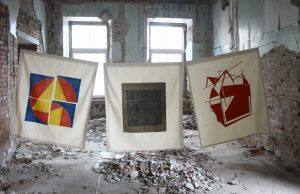
Running concurrently with this installation was an exhibition in the Vitebsk Centre for Contemporary Art, comprising printmaking, video and sculpture from all three artists. My floor-based piece, monUment, was directly inspired by Malevich’s architectons, modular, monochromatic sculptural forms made during his time in Vitebsk which formed an exploration of the language of architecture. The piece was mounted on top of original UNOVIS era wooden floor tiles. The show also featured relief prints by Josh Dannin and a video installation by Sean Hanrahan.
- Over the Sun - installation view
- monUment - mixed media
- monUment - mixed media, detail
In addition to these elements I also produced a lithograph for the exhibition using a piece of the wooden floor tiling, and a section of plaster moulding salvaged from the original building. These were cast in fine paper pulp, and the resulting paper moulds were inked up and their textures applied to a lithography stone.
- 5A, lithograph - object cast in paper pulp
- materials used to make 5A, lithograph
The resulting print, 5A, is intended to form a direct snapshot of the history and activities of the building’s past, and to be consistent with the aesthetic ideals of Malevich’s Suprematist movement.
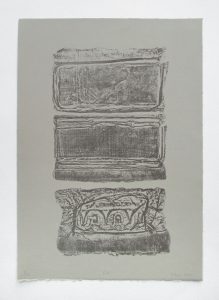
To learn more about Suprematism, why not make your own Malevich painting on my ArtMovement site here ?
Photography of exhibition installations by Sean Hanrahan.
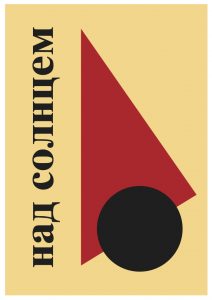
Artist’s statement for Over the Sun:
My first encounter with the work of Kazimir Malevich was in 1995 while perusing a very large book which surveyed the history of 20th century art. Every chapter covered a specific year, a prominent artist being highlighted and examined. 1915 belonged to Malevich. A large reproduction of his famous “Black Square” dominated the page, the writing containing rousing declarations of “a new era of sensation”, “the zero of form” and a “new pictorial realism”. At that time, with a slightly cynical attitude, I wondered how such a seemingly unremarkable, simple work could generate such intensity of feeling and art-historical scrutiny. I even made the Suprematist work of Malevich the subject of my degree thesis. Though the thesis is long lost, I remember a good deal of the reading and research revolving around mystical notions of the fourth dimension, the paintings supposedly allowing the viewer to access transcendent states of elevated consciousness.
It was a few years later before I had the opportunity to view Malevich’s Suprematist paintings in the flesh. Encountering the work directly provided an unexpected experience. Up close, these works are very painterly, the edges of the forms are diffuse and the brushwork very evident. To me, the geometric shapes in the works had a very grounded presence in pigment and material, the evidence of the human hand lending them a familiar, intimate feel. I was also becoming more interested in Malevich’s series of architektons. These abstract three-dimensional forms had obvious allusions to architecture, but didn’t concern themselves with the practical issues architects must deal with, such as interior space or feasibility of construction. It appeared that the actual language of architecture and form was what was being explored. As I continued to develop my own sculptural practice, I became aware of a debt to Malevich. Artists are now free to use any materials to explore issues of scale and volume, and to simply occupy space in sculptural terms, free from the constraint of having to reference or mimic the world. While we may largely take this for granted now, somebody had to create this freedom for us. For me that person remains Kazimir Malevich.

